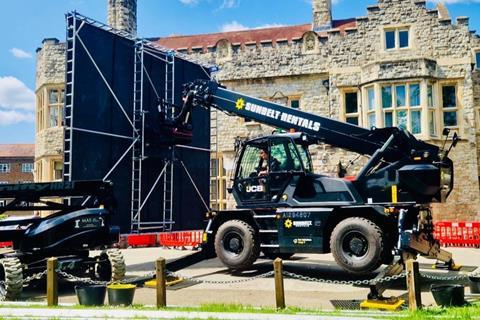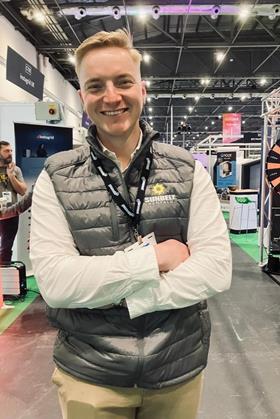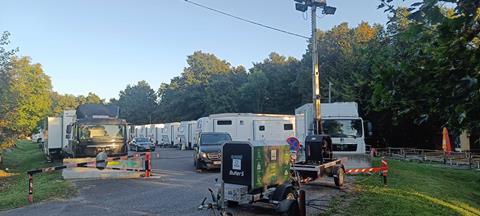IBC365 speaks with key players on the new technologies, methods and practices available to productions to help sustain the future of content.
Global screen industries emitted more than 130,000 tonnes of CO2 in 2022 according to an international report by BAFTA albert, urging an industry-wide commitment to net zero carbon emissions by 2050.

Whilst studio production often follows sustainability protocols established by albert, filming away from the comfort of these facilities presents a series of energy consumption issues. So what can productions do on location to ensure everyone is working towards the same goal?
The knowledge gap
Lily Limmer, Sustainability Consultant at Picture Zero, worked as a Sustainability Officer for Apple TV’s The Essex Serpent, which won two awards around sustainability (including the British Film Designers Guild’s (BFDG) Planet Positive Award). She explained that ‘sustainable production’ means incorporating practices from the ground up: “We wanted to attempt to tackle every sustainability issue with (The Essex Serpent), knowing that we probably wouldn’t be able to do much in a lot of the areas (on location), but would at least come away with loads of learnings about what the obstacles were.”
“We as an industry risk missing out on (cleaner energy) entirely because we are so reliant on generator use and diesel vehicles.” - Lily Limmer, Sustainability Consultant at Picture Zero
Firstly, the team used waste hydrotreated vegetable oil (HVO) - certified HVO which is a byproduct of the agriculture industries - as fuel instead of diesel: “We managed to swap out all diesel for HVO in all of our generators - it roughly generates 89% less carbon emissions than diesel - which was tricky at the time because suppliers weren’t used to the fuel and so we had to convince a lot of people that it would be okay,” she says.

Limmer went on to refer to this technique as a “sticking plaster” whilst the industry invests in battery technology. “The uptake of these fuels is going to soon outstrip the waste supply and I’m worried we’re already at the point where palm oil is making its way into the fuels. It’s not a solution, it’s an emergency step.”
The production also prioritised cutting emissions on lighting; using electric taxis for transporting cast, crew and kit; using a specialist waste service; and donating excess catering to food banks.
Limmer spoke of the fluctuation in the load from the generators due to energy demand being inconsistent during shoots and causing massive spikes in power consumption:
“Generators have an optimal load so for your generator to be efficient, you really want the load to be about 70 to 80% of the capacity of the generator,” which is achieved with hybrid generators.
“At the moment with locations needing mobile power, (in the UK) our industry is just addicted to fossil fuels and we are failing to make use of our National Grid (as it’s) becoming much cleaner and it will become cheaper as renewables become more available. We as an industry risk missing out on that entirely because we are so reliant on generator use and diesel vehicles.”
Read more Webinar: Measuring and reducing the footprint of streaming workflows
George Woodiwiss, Sustainable Applications Manager at Sunbelt Rentals UK and Ireland, who co-leads Sunbelt Rentals’ mission to find opportunities for sustainable solutions, spoke of one of the biggest hurdles right now: “Lack of education about the availability, functionalities, and benefits of sustainable equipment.”

Alongside hybrid generators, the sustainable equipment supplied by Sunbelt Rentals includes hybrid and solar lighting, stage V generators, electric Scarab (all-terrain vehicle), and hybrid and electric access equipment (mobile access platforms).
“Some people may be hesitant to embrace these solutions due to the fear of the unknown, but it’s important for us to collaborate with industry stakeholders and partners to discuss the production requirements and implement sustainable alternatives, demonstrating what is possible,” adds Woodiwiss.
Zsófia Szemerédy, Co-Founder at Green Eyes Production and former International Manager at BAFTA albert, has worked on productions such as Netflix series All the Light you Cannot See, Apple TV+’s Hijack and Oscar-winning feature Poor Things, and finds solutions for sustainable practices for businesses throughout the production process. Her advice is to premeditate measures for reducing emissions, because if productions don’t think about sustainability early on, “it’s like putting a plaster on an open wound.”
“Everyone has a responsibility to consider sustainability as a priority now.” - Zsófia Szemerédy, Co-Founder at Green Eyes Production
Szemerédy emphasised the urgent need for investment in clean energy at the earliest stage possible. “That’s why we have sustainability green light training (to encourage productions to implement sustainability as soon as they receive the ‘green light’),” she says. “And that has an influence on what happens on the ground and when you go out on location… It has a direct impact on it.”
Who picks up the bill?
Travel is the biggest footprint in production recorded by the albert report. Limmer revealed survey results from crew detailing that unsociable hours, remote locations and shoot times meant greener travel was often not an option.
Limmer also notes that converting to cleaner energy and greener travel (versus domestic flights) adds up: “(Financing changes) varies from streamer to streamer, broadcaster to broadcaster, studio to studio. There are some broadcasters and studios who now have centralised sustainability teams and are making funding available, so that does happen. But there’s no cohesion across the industry as to how that works.”
By understanding the positive impact of sustainable equipment, with commercial and carbon-saving benefits, informed decisions can be made.” - George Woodiwiss, Sustainable Applications Manager at Sunbelt Rentals UK and Ireland
Szemerédy believes that the UK’s major setback is a lack of financial support: “How do you expect to mandate anything, without the financial support in place to aid a just transition?” She explains that there was one popular idea floating around the industry, to ‘repurpose’ the Covid budget, infrastructure and crew.

“There is a trained source of power there, if they could be re-trained to be sustainability assistants and support on the ground that would be immensely helpful,” she says. “Similarly with budgets, the transition will undeniably cost money, for streamers, broadcasters, productions and not in a small part for suppliers. If there were an industry ‘pool’, such as an ‘insetting pool’ aiding a just transformation that could really speed up the process.
“I’m a firm believer of the holy trinity: tax incentives aiding sustainable initiatives, a baseline of minimum standard requirements and lastly third-party auditing keeping the industry in check, making sure we put our money where our mouth is.”
Szemerédy applauded countries who are setting stronger financial incentives: “Austria last year offered 30% tax incentives and a 5% bonus if the sustainability requirements are fulfilled.”
She added that Germany requires minimum standards, New Zealand and Slovakia are already “offering sustainability support in some shape or form amongst other countries, and Hungary announced last year that they have plans for the domestic industry.
“It’s about being ready to adapt to what is coming,” she says.
Read more People & Purpose - Episode 1: How to set up an international mentoring scheme
Szemerédy urges all productions to measure data, across the content chain – the more data the stronger these improvements can be: “(Overall) the most important thing is collaboration and information sharing, alongside accurate data collection. If we’d have all of this, we’d have a really good base to start ourselves off from.”

Woodiwiss agrees: “Without awareness about the possibilities and collaboration between productions, suppliers, and manufacturers, embracing these options can seem daunting… By understanding the positive impact of sustainable equipment, with commercial and carbon-saving benefits, informed decisions can be made… The long-term savings and environmental benefits far outweigh (initial) cost.”
New tech and easy wins
Despite current CO2 emissions, Woodiwiss is optimistic about changes in the industry given progress on recent projects: “One of our most successful and noteworthy greener energy solutions is the implementation of the ‘Power at Mains Parallel’ system installed at a London-based studio for Marmalade films,” said Woodiwiss. “It utilised the existing mains supply to charge large battery storage units, subsidising the available mains power at peak times without the need for generators.” This resulted in thousands of pounds saved and significantly reduced CO2 emissions. He also mentioned the increased storage capabilities and port abilities of batteries.

According to Limmer, developments have come in leaps and bounds, “E-vis battery company are using batteries from London buses, so no lithium or cobalt mining,” adding that the industry is also consolidating with construction companies to share power supplies.
Szemerédy pointed out that many productions are turning to LED lighting for a longer lifespan and less energy consumption. “Upon talking to suppliers, especially rental houses, they tend to proudly point out, that lighting and camera equipment evolved a lot in the last few decades and they use a lot less energy than before. Sometimes the unit base requires more energy, and steadier flow, than the set – depending on the setup of course. Some of the transition inspired a need for mobility and reducing the amount of cabling, but this comes in handy from a sustainability perspective as well.”
The bigger picture
Szemerédy believes that the game changers will be tax incentives, ESG regulations, and studios and streamers budgeting for sustainable changes, from commissioning to distribution: “It all trickles down.”

For Woodiwiss: “I would like to see everyone in the industry becoming advocates for the adoption of greener technologies, as well as taking a proactive approach to looking for solutions with a lower carbon footprint,” adding that collaboration is key.
According to Limmer it can be “easy to be disheartened when you are focused on solving the problem, because everywhere you look there are issues.
“But I’ve been pretty amazed by how genuinely interested in being better these studios and corporate entities are. We as a business have committed to net zero. Things need to happen so much faster… I just hope that people are aware of the good news that is happening.
“I think if it continues at that rate and more people get involved we have a really, really good chance for this industry which is so fast, we’re very adaptable and we can change things very, very quickly.”
Read more Sustainability in Production: The albert Report Tells What’s What and Who’s Who
























No comments yet